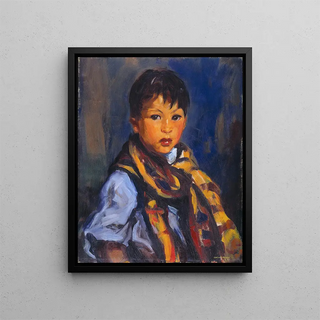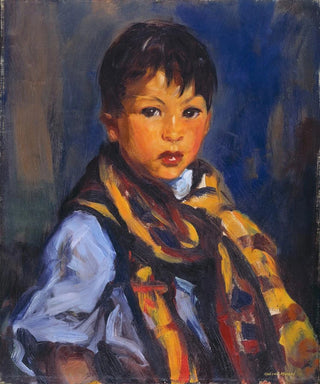Art print | Boy with checkered scarf - Robert Henri Source: Reproduction | Garçon avec écharpe à carreaux - Robert Henri


View from behind

Frame (optional)
In the fascinating world of early 20th-century American painting, Robert Henri's "Boy with Plaid Scarf" stands out for its ability to capture the very essence of youth and innocence. This canvas, vibrant with life and color, transports us to a suspended moment where the gaze of the young boy, both mischievous and contemplative, engages us. Henri, master of the portrait, manages to infuse a psychological depth into his subjects, making them almost tangible. The art print of this iconic work allows us to rediscover the magic of painting while adding a touch of elegance and authenticity to our living spaces.
Style and uniqueness of the work
Robert Henri's style is often associated with the realist movement, but he transcends simple representation techniques to explore emotional and psychological dimensions. In "Boy with Plaid Scarf," the artist uses bold brushstrokes and rich colors that create a vibrant atmosphere. The play of light and shadow accentuates the features of the young boy's face, while the plaid scarf becomes a central element of the composition, adding a touch of modernity and dynamism. This work is characterized by an intimate approach and a keen sense of observation, allowing the viewer to feel an immediate connection with the subject. The color palette, both soft and bright, evokes a unique sensitivity that makes this piece a true masterpiece.
The artist and his influence
Robert Henri, an emblematic figure of the New York School, profoundly shaped the American artistic landscape. Born in 1865, he established himself as a pioneer of modern realism, influencing many contemporary and future artists. His vision of art, focused on the importance of everyday life and portraits, paved the way for a new way of approaching painting. Henri was also a passionate advocate of art education, sharing his passion and knowledge with his students. His humanist approach and desire to depict the truth of human beings made him a forerunner in portrait art.

Matte finish

View from behind

Frame (optional)
In the fascinating world of early 20th-century American painting, Robert Henri's "Boy with Plaid Scarf" stands out for its ability to capture the very essence of youth and innocence. This canvas, vibrant with life and color, transports us to a suspended moment where the gaze of the young boy, both mischievous and contemplative, engages us. Henri, master of the portrait, manages to infuse a psychological depth into his subjects, making them almost tangible. The art print of this iconic work allows us to rediscover the magic of painting while adding a touch of elegance and authenticity to our living spaces.
Style and uniqueness of the work
Robert Henri's style is often associated with the realist movement, but he transcends simple representation techniques to explore emotional and psychological dimensions. In "Boy with Plaid Scarf," the artist uses bold brushstrokes and rich colors that create a vibrant atmosphere. The play of light and shadow accentuates the features of the young boy's face, while the plaid scarf becomes a central element of the composition, adding a touch of modernity and dynamism. This work is characterized by an intimate approach and a keen sense of observation, allowing the viewer to feel an immediate connection with the subject. The color palette, both soft and bright, evokes a unique sensitivity that makes this piece a true masterpiece.
The artist and his influence
Robert Henri, an emblematic figure of the New York School, profoundly shaped the American artistic landscape. Born in 1865, he established himself as a pioneer of modern realism, influencing many contemporary and future artists. His vision of art, focused on the importance of everyday life and portraits, paved the way for a new way of approaching painting. Henri was also a passionate advocate of art education, sharing his passion and knowledge with his students. His humanist approach and desire to depict the truth of human beings made him a forerunner in portrait art.






